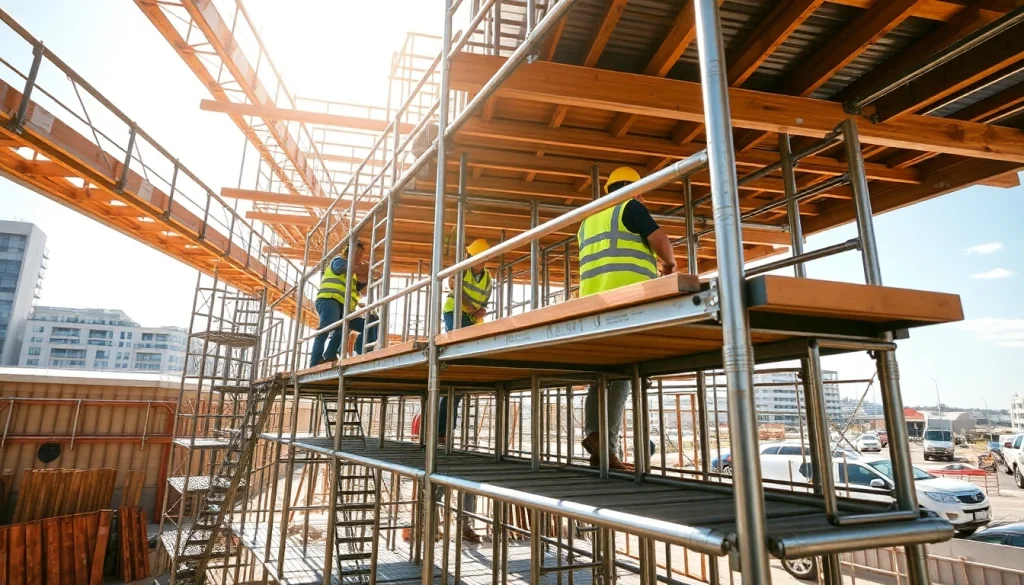Understanding Whangarei Scaffolding: A Comprehensive Overview
Scaffolding is a crucial element in construction and maintenance industries, providing essential support and safety for various building projects. In Whangarei, as in other regions, scaffolding is employed to ensure efficient, safe, and effective construction practices. Whether for residential, commercial, or industrial projects, understanding the specifics of Whangarei scaffolding is fundamental for stakeholders and contractors alike. This guide delves into the intricacies of scaffolding in Whangarei, including its importance, applications, and much more.
What is Whangarei Scaffolding?
Whangarei scaffolding refers to the temporary structures designed to support workers and materials during the construction or repair of buildings. These structures can vary widely in size and form based on the project requirements. Additionally, the scaffolding can come in different types, including fixed, mobile, and suspended styles, depending on the work site and specific tasks at hand.
The Importance of Quality Scaffolding
Quality scaffolding is vital for several reasons: it enhances worker safety, improves productivity, and ensures compliance with local regulations. When scaffolding is constructed correctly, it minimizes the risks of falls and accidents, which are some of the leading causes of injuries in construction environments. Moreover, using durable and well-maintained scaffolding can expedite construction timelines, promoting cost efficiency in projects.
Common Applications in Whangarei
In Whangarei, scaffolding is used in various applications including but not limited to:
- Residential Projects: Scaffolding is often employed for renovations or new builds, enabling access to hard-to-reach areas.
- Commercial Developments: Larger scaffolding systems support more extensive structures, such as office buildings or shopping centers, facilitating significant construction efforts.
- Industrial Maintenance: Scaffolding allows maintenance teams access for repair work on factories and plants.
- Event Structures: Temporary scaffolding is also used for buildings and stages during community events and festivals.
Types of Scaffolding Used in Whangarei
System Scaffolding vs. Frame Scaffolding
In Whangarei, two popular scaffolding systems are system scaffolding and frame scaffolding. System scaffolding consists of prefabricated modular units that can be built quickly and easily adapted to different configurations. In contrast, frame scaffolding is more traditional, composed of metal frames and can be assembled and disassembled on-site, providing flexibility for varied project sizes.
Mobile Scaffolding: Flexibility for Various Projects
Mobile scaffolding systems are equipped with wheels, allowing them to move easily from one location to another on a job site. This type of scaffolding is particularly beneficial for tasks such as interior painting or installations, where workers require fast and versatile access to different areas without the need for complete reassembly.
Specialized Scaffolding Solutions
Some projects in Whangarei may require specialized scaffolding solutions, such as weather protection or safety nets. These options are tailored for specific projects, such as those requiring environmental control or enhanced safety measures to protect workers and bystanders.
Choosing the Right Scaffolding Provider in Whangarei
Key Factors to Consider
Selecting the appropriate scaffolding provider is essential for ensuring safety and project success. Key factors to consider include:
- Experience and Reputation: Look for providers with a solid track record and positive client testimonials.
- Range of Services: Ensure the company offers various types of scaffolding and related services to meet your project needs.
- Local Knowledge: A provider familiar with local regulations and construction practices can facilitate a smoother project process.
Evaluating Safety Standards
Safety should be a top priority when choosing a scaffolding provider. Evaluate the company’s safety record, the training provided to its employees, and its adherence to the required safety standards and regulations. Ask about the scaffolding equipment’s condition, including regular maintenance routines, to ensure optimal safety.
Customer Reviews and Testimonials
Investigating customer feedback is crucial for making an informed selection. Look for online reviews, ratings, and testimonials to gauge previous clients’ experiences. A reputable provider will proudly share positive feedback and demonstrate a commitment to customer satisfaction.
Regulations and Safety Standards for Whangarei Scaffolding
Local Safety Regulations Overview
In Whangarei, scaffolding regulations are influenced by national safety legislation, as well as local building codes. Providers must comply with guidelines that cover everything from the structural integrity of scaffolding systems to the qualifications required for personnel setting up scaffolds. Understanding these regulations ensures compliance and promotes a safer working environment.
Best Practices for Scaffold Safety
To uphold safety standards, several best practices should be followed on construction sites:
- Regular Inspections: Conduct frequent inspections of scaffolding to identify potential hazards before they lead to accidents.
- Proper Training: Ensure all workers involved in scaffolding setup and use are adequately trained and understand safety protocols.
- Use Fall Protection Measures: Implement guardrails, safety harnesses, and other fall protection systems to enhance overall site safety.
How to Ensure Compliance
To ensure compliance with local and national standards, keep detailed records of inspections and training. Engage with regulatory bodies and remain updated on any changes to regulations. This proactive approach promotes a culture of safety within construction operations.
Future Trends in Whangarei Scaffolding
Adoption of Technology in Scaffolding
Technology is reshaping construction, including scaffolding practices. The implementation of digital tools like scaffolding design software and building information modeling (BIM) can enhance project efficiency and safety. These tools allow for better planning and visualization, ultimately reducing errors and improving coordination on site.
Eco-Friendly Scaffolding Options
As sustainability becomes increasingly important, eco-friendly scaffolding options are gaining popularity. Providers may explore alternatives like reusable scaffolding materials, low-impact assembly processes, and eco-friendly coatings that contribute to sustainable construction practices.
The Impact of Urban Development on Scaffolding Demand
The ongoing urban development in Whangarei leads to increased demand for scaffolding solutions. As the population grows and infrastructure expands, the need for efficient and safe scaffolding practices will remain crucial for both new constructions and renovations of existing structures. Understanding these trends is vital for stakeholders in making informed decisions regarding future projects.
